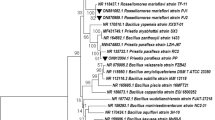Abstract
Fungal isolates from salmonid eggs displayed apparently unique patterns of biochemical characteristics at both the generic and specific levels. of the five genera examinedAchlya andPythium were able to assimilate 13–16 out of 19 carbohydrates.Aphanomyces was able to assimilate only glucose and starch, which was assimilated by all isolates. Members ofSaprolegnia displayed identical patterns of carbohydrate assimilation, except forS. hypogyna, which was also able to assimilate melibiose, in common withAchlya, Pythium, andLeptolegnia. Pythium was the only genus capable of assimilating salicin. OnlyAchlya andP. monospermum were able to assimilate rhamnose. In terms of amino acid assimilation isolates ofSaprolegnia ferax andS. diclina displayed an identical patterns, as did isolates ofS. parasitica andS. hypogyna. OnlyAphanomyces frigidophilus isolate was capable of assimilating cysteine. All genera exceptPythium assimilated glutamine, a fundamental amino acid. All isolates exhibited lipase and fatty acid esterase activities but no cellulase acitivity. The biochemical characteristics discovered in this study offer possibilities for identification and classification of these fungi, which are discussed herein.
Similar content being viewed by others
Literature cited
Beakes, G. and Ford, H. 1983. Esterase isoenzyme variation in the genusSaprolegnia, with particular reference to the fish-pathogenicS. diclina-parasitica complex. J. Gen. Microbiol.129: 2605–2619
Bridge, P. D. 1987. A note on use and interpretation of nitrite assimilation tests inPenicillium systematics. Trans. Br. Mycol. Soc.,88: 569–571.
Bridge, P. D. and Hawksworth, D. L. 1985. Biochemical tests as an aid to identification ofMonascus species. Letters Appl. Microbiol.,1: 25–29.
Bridge, P. D., Hawksworth, D. L., Kozakiewicz, Z., Onions, A. H. S., Paterson, R. R. M., Sackin, M. J. and Sneath, P. H. A. 1989. A reappraisal of the terverticillate penicillia using biochemical, physiological and morphological features I. Numerical taxonomy. J. Gen. Microbiol135: 2941–2966.
Bridge, P. D., Ismail, M. A. and Rutherford, M. A. 1993a. An assessment of aesculin hydrolysis, vegetative compatibility and DNA polymorphism as criteria for characterizing pathogenic races withinFusarium oxysporum f. sp.vasinfectum. Plant Pathol.,42: 264–269.
Bridge, P. D., Williams, M. A. J., Prior, C. and Paterson, R. R. M. 1993b. Morphological, biochemical and molecular characteristics ofMetarhizium anisopliae andM. flavoviride. J. Gen. Microbiol.,149: 1163–1169.
Frisvad, J. C. 1981. Physiological criteria and mycotoxin production as aids in identification of common asymmetric penicillia. Appl. Environ. Microbiol.,41: 568–579.
Hill, T. W. and Mullins, J. T. 1980. Hyphal growth tip inAchlya. II. Subcellular localization of cellulase and associated enzymes. Can. J. Microbiol.,26: 1141–1146.
Papavizas, G. C. and Ayer, W. A. 1964. Effect of various carbon sources on growth and sexual reproduction ofAphanomyces euteiches. Mycologia,56: 816–831.
Pateman, J. A. and Kinghorn, J. R. 1976. Nitrogen metabolism. In: The filamentous fungi. vol. 2, Biosynthesis and metabolism, (ed. by Smith, J. E. and Berry, D. R.), pp. 159–237. Academic Press, London.
Paterson, R. R. M. and Bridge, P. D. 1994. Biochemical techniques for filamentous fungi. CAB International UK.
Rand, R. G. and Munden, D. 1992. Enzyme involvement in the invasion of brook char,Salvelinus fontinalis (Mitchell), eggs bySaprolegnia diclina (Oomycotina: Saprolegniaceae). J. Fish Dis.15: 91–94.
Schreurs, W. J. A., Harold, R. L. and Harold, F. M. 1989. Chemotropism and branching as alternative responses ofAchlya bisexualis to amino acids. J. Gen. Microbiol.,135: 2519–2528.
Willoughby, L. G. 1978. Saprolegnias of salmonid fish in Windermere: a critical analysis. J. Fish Dis.1: 51–67.
Wood, S. E., Willoughby, L. G. and Beakes, G. W. 1987. Experimental studies on uptake and interaction of spores of theSaprolegnia diclina-parasitica complex with external mucus of brown trout (Salmo trutta). Trans. Br. Mycol. Soc.90: 63–73.
Yuasa, K. 1995. Studies on taxonomy of pathogenic fungi from fishes with saprolegniasis. PhD thesis, Nippon Veterinary and Animal Science University, Musashino, Tokyo.
Author information
Authors and Affiliations
About this article
Cite this article
Kitancharoen, N., Hatai, K. Some biochemical characteristics of fungi isolated from salmonid eggs. Mycoscience 39, 249–255 (1998). https://doi.org/10.1007/BF02464005
Accepted:
Issue Date:
DOI: https://doi.org/10.1007/BF02464005




